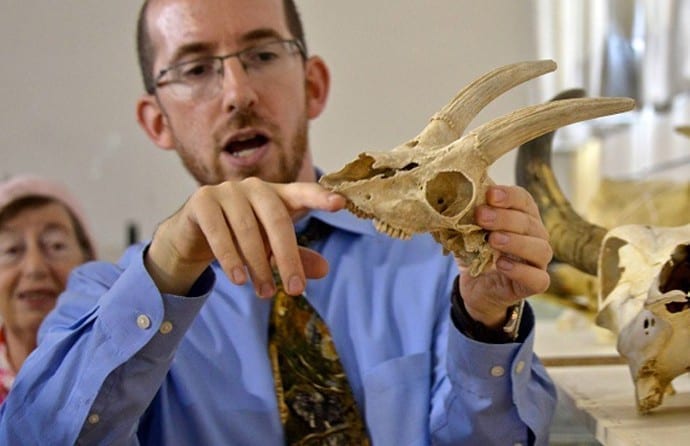
What makes the griffon vulture, the Biblical nesher , so light in flight that the sages said: (Avot 5: 20) Be as light as the Nesher? If you want to know the answer to such a question, the best person to ask is Natan Slifkin. A veritable walking encyclopedia of knowledge of all biblical animals, Slifkin (known by his peers as “the zoo rabbi”) has now opened the first Biblical Museum of Natural History in Beit Shemesh, Israel, where he teaches and provides an interactive experience with a large number of biblical animals. The larger animals are visible in taxidermy form — after all, this is not exactly a zoo, it is a museum. However the smaller reptiles and animals are available for hands-on instruction, and one can see young children there thrilled to handle snakes and other reptiles for the first time.
The museum-cum-zoo also serves as a center for studying the Torah topics associated with animals. It boasts an array of exotic shofars and even offers a practical demonstration of the skeletons of animals which can be used for a shofar. It also features several creatures which are not actually mentioned in the Torah but present intriguing questions regarding kashrut.
The museum also seeks to enlighten visitors regarding certain creatures in the Torah which are difficult to identify. For example, The Torah and Talmud discuss eight categories of small, creeping animals that are considered unclean. These include rodents and lizards, as well as other animals. But much confusion surrounds their identification, leading to some Modern Hebrew names for these animals that might not correspond to the correct identities of the Biblical animals. The museum specimens explore the true identities of these creatures and enable people who have studied about them all their lives to encounter them in real life.
Slifkin is a recognized expert at identifying Biblical creatures and has just published the first volume of his “Torah encyclopedia of the Animal Kingdom”, the results of fourteen years of meticulous research. Slifkin emphasizes that “the nesher is not the eagle as people commonly call it, but rather the griffon vulture and due to its wide wingspan it is able to fly without beating its wings at all by riding the thermal currents. The Sages wanted to teach us to imitate the vulture and soar effortlessly and with alacrity to perform the will of Hashem, but we can see how keenly they observed the animal life around them and sought to derive lessons for life from them.”
The Sages also emphasize that one should be “as courageous as a lion”. This does not necessarily connote physical strength, says Slifkin, since in another place the Sages say that a true man of courage is one who controls his instincts. “The lion tends to live in a pride with all its family as opposed to other predators which tend to live alone. This is because the lion is capable of controlling its aggressive nature and therefore the analogy for humans is to control one’s nature and attain true courage like that of a lion.”
How do you know exactly how to identify these animals?
“The identification can be made from bone remains as well as from juxtaposing relevant information which can be gleaned from ancient sources. Some names are more generic; The tanin could refer to the crocodiles which were known to exist in ancient Israel and were even seen there the beginning of the 20th century, but it could also refer to a whale in some contexts. Other names are more specific but not always easy to recognize in modern terms.”
Slifkin suggests that the Yachmor, mentioned among the Kosher animals is the hartebeest, an African species of antelope, but he is not certain of this identification. However regarding the re’em, a species mentioned a number of times in conjunction with cows, he is more convinced that it matches the auruchs, a species of wild ox which is now extinct but whose bone remains mirror the type of powerful horns which the re’em was supposed to have had. Previous translations had rendered this animal as a unicorn, which even if it existed only had one horn, whereas the re’em had at least two. Slifkin derives from various biblical sources that the re’em is similar to domestic cattle, but it is a powerful, dangerous animal, and it possesses two magnificent ,upwards-pointing horns- all of which point to the aurochs.
Slifkin, who claims that he has had a “lifelong passion” for animals, is also a prolific author who has written extensively about Torah and science. However his opinions on dinosaurs and the age of the world got him embroiled in controversy, as he adopted a minority opinion of the early authorities which could reconcile Torah and evolution. The museum, however, has no dinosaurs and does not deal at all with paleontology, as Slifkin has no wish to be involved in polemics with regard to his passion for animals.
Slifkin believes that there are numerous real life lessons to be learned from animals. Just as Shlomo Hamelech tells us to go to the ant and derive wisdom from its behavior, Slifkin demonstrates that one can deepen one’s knowledge of the Bible and of human nature through observing the wonderful creations of G-d.
The museum website is at http://www.biblicalnaturalhistory.org/.
